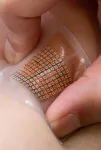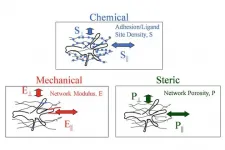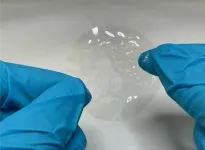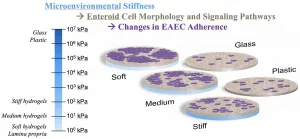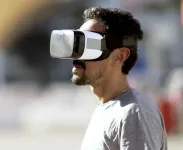(Press-News.org) Engineers at the University of California San Diego developed a soft and stretchy ultrasound patch that can be worn on the skin to monitor blood flow through major arteries and veins deep inside a person's body.
Knowing how fast and how much blood flows through a patient's blood vessels is important because it can help clinicians diagnose various cardiovascular conditions, including blood clots; heart valve problems; poor circulation in the limbs; or blockages in the arteries that could lead to strokes or heart attacks.
The new ultrasound patch developed at UC San Diego can continuously monitor blood flow--as well as blood pressure and heart function--in real time. Wearing such a device could make it easier to identify cardiovascular problems early on.
A team led by Sheng Xu, a professor of nanoengineering at the UC San Diego Jacobs School of Engineering, reported the patch in a paper published July 16 in Nature Biomedical Engineering.
The patch can be worn on the neck or chest. What's special about the patch is that it can sense and measure cardiovascular signals as deep as 14 centimeters inside the body in a non-invasive manner. And it can do so with high accuracy.
"This type of wearable device can give you a more comprehensive, more accurate picture of what's going on in deep tissues and critical organs like the heart and the brain, all from the surface of the skin," said Xu.
"Sensing signals at such depths is extremely challenging for wearable electronics. Yet, this is where the body's most critical signals and the central organs are buried," said Chonghe Wang, a former nanoengineering graduate student in Xu's lab and co-first author of the study. "We engineered a wearable device that can penetrate such deep tissue depths and sense those vital signals far beneath the skin. This technology can provide new insights for the field of healthcare."
Another innovative feature of the patch is that the ultrasound beam can be tilted at different angles and steered to areas in the body that are not directly underneath the patch.
This is a first in the field of wearables, explained Xu, because existing wearable sensors typically only monitor areas right below them. "If you want to sense signals at a different position, you have to move the sensor to that location. With this patch, we can probe areas that are wider than the device's footprint. This can open up a lot of opportunities."
How it works
The patch is made up of a thin sheet of flexible, stretchable polymer that adheres to the skin. Embedded on the patch is an array of millimeter-sized ultrasound transducers. Each is individually controlled by a computer--this type of array is known as an ultrasound phased array. It is a key part of the technology because it gives the patch the ability to go deeper and wider.
The phased array offers two main modes of operation. In one mode, all the transducers can be synchronized to transmit ultrasound waves together, which produces a high-intensity ultrasound beam that focuses on one spot as deep as 14 centimeters in the body. In the other mode, the transducers can be programmed to transmit out of sync, which produces ultrasound beams that can be steered to different angles.
"With the phased array technology, we can manipulate the ultrasound beam in the way that we want," said Muyang Lin, a nanoengineering Ph.D. student at UC San Diego who is also a co-first author of the study. "This gives our device multiple capabilities: monitoring central organs as well as blood flow, with high resolution. This would not be possible using just one transducer."
The phased array consists of a 12 by 12 grid of ultrasound transducers. When electricity flows through the transducers, they vibrate and emit ultrasound waves that travel through the skin and deep into the body. When the ultrasound waves penetrate through a major blood vessel, they encounter movement from red blood cells flowing inside. This movement changes or shifts how the ultrasound waves echo back to the patch--an effect known as Doppler frequency shift. This shift in the reflected signals gets picked up by the patch and is used to create a visual recording of the blood flow. This same mechanism can also be used to create moving images of the heart's walls.
A potential game changer in the clinic
For many people, blood flow is not something that is measured during a regular visit to the physician. It is usually assessed after a patient shows some signs of cardiovascular problems, or if a patient is at high risk.
The standard blood flow exam itself can be time consuming and labor intensive. A trained technician presses a handheld ultrasound probe against a patient's skin and moves it from one area to another until it's directly above a major blood vessel. This may sound straightforward, but results can vary between tests and technicians.
Since the patch is simple to use, it could solve these problems, said Sai Zhou, a materials science and engineering Ph.D. student at UC San Diego and co-author of the study. "Just stick it on the skin, then read the signals. It's not operator dependent, and it poses no extra work or burden to the technicians, clinicians or patients," he said. "In the future, patients could wear something like this to do point of care or continuous at-home monitoring."
In tests, the patch performed as well as a commercial ultrasound probe used in the clinic. It accurately recorded blood flow in major blood vessels such as the carotid artery, which is an artery in the neck that supplies blood to the brain. Having the ability to monitor changes in this flow could, for example, help identify if a person is at risk for stroke well before the onset of symptoms.
The researchers point out that the patch still has a long way to go before it is ready for the clinic. Currently, it needs to be connected to a power source and benchtop machine in order to work. Xu's team is working on integrating all the electronics on the patch to make it wireless.
INFORMATION:
Paper: "Continuous monitoring of deep-tissue haemodynamics with stretchable ultrasonic phased arrays." Co-authors include Baiyan Qi*, Zhuorui Zhang*, Mitsutoshi Makihata, Boyu Liu, Yi-hsi Huang, Hongjie Hu, Yue Gu, Yimu Chen, Yusheng Lei, Shu Chien and Erik Kistler, UC San Diego; Taeyoon Lee, Yonsei University and Korea Institute of Science and Technology; and Kyung-In Jang, Daegu Gyeonbuk Institute of Science and Technology, Republic of Korea.
*These authors contributed equally
This work was supported by the National Institutes of Health (grant 1R21EB027303-01A1) and the Center for Wearable Sensors at the UC San Diego Jacobs School of Engineering.
Irvine, Calif., July 22, 2021 - To meet an ambitious goal of carbon neutrality by 2045, California's policymakers are relying in part on forests and shrublands to remove CO2 from the atmosphere, but researchers at the University of California, Irvine warn that future climate change may limit the ecosystem's ability to perform this service.
In a paper published today in the American Geophysical Union journal AGU Advances, the UCI Earth system scientists stressed that rising temperatures and uncertain precipitation will cause a decrease in California's natural carbon storage capacity of as much as 16 percent under an extreme climate projection and of nearly 9 percent under a more moderate scenario.
"This work highlights the conundrum ...
ITHACA, N.Y. - A new method that analyzes how individual immune cells react to the bacteria that cause tuberculosis could pave the way for new vaccine strategies against this deadly disease, and provide insights into fighting other infectious diseases around the world.
The cutting-edge technologies were developed in the lab of Dr. David Russell, the William Kaplan Professor of Infection Biology in the Department of Microbiology and Immunology in the College of Veterinary Medicine, and detailed in new research published in the Journal of Experimental Medicine on July 22.
For years, Russell's lab has sought to unravel how Mycobacterium tuberculosis (Mtb), the bacteria that cause tuberculosis, infect and persist in their host cells, which are typically ...
A new study, led by University of Minnesota Twin Cities engineering researchers, shows that the stiffness of protein fibers in tissues, like collagen, are a key component in controlling the movement of cells. The groundbreaking discovery provides the first proof of a theory from the early 1980s and could have a major impact on fields that study cell movement from regenerative medicine to cancer research.
The research is published in the Proceedings of the National Academy of Sciences of the United States of America (PNAS), a peer-reviewed, multidisciplinary, high-impact scientific journal.
Directed cell movement, or what scientists call "cell contact guidance," refers to a phenomenon when the orientation of cells ...
Researchers at the University of São Paulo (USP) in Brazil investigated the effects of regular exercise on the physical and mental health of 344 volunteers during the pandemic. The study compared the effectiveness of three techniques: sessions led in person by a fitness instructor, sessions featuring an online instructor but no supervision, and sessions supervised remotely by an instructor via video call.
The two kinds of session with professional supervision had the strongest effects on physical and mental health. According to the researchers, this was due to the possibility of increasing ...
New Brunswick, NJ--Even at term, gestational age may have an impact on children's academic performance, findings of a new study suggest. The research showed an association between gestational age at term and above-average rankings in a number of academic subjects.
The study, published in Pediatrics, compared teacher-reported outcomes for 1,405 9-year-old children in the United States, analyzing performance in mathematics, science and social studies, and language and literacy, for those born at 37 through 41 weeks gestation. It found that longer gestational age was significantly associated with average or above-average rankings in all areas. It also suggested a general pattern of worse outcomes for children born at early term (37-38 weeks) and better outcomes for those born at late ...
Plastics offer many benefits to society and are widely used in our daily life: they are lightweight, cheap and adaptable. However, the production, processing and disposal of plastics are simply not sustainable, and pose a major global threat to the environment and human health. Eco-friendly processing of reusable and recyclable plastics derived from plant-based raw materials would be an ideal solution. So far, the technological challenges have proved too great. However, researchers at the University of Göttingen have now found a sustainable method - "hydrosetting", which uses water at normal conditions - to process and reshape a new type of hydroplastic polymer called cellulose cinnamate (CCi). The research was published ...
HOUSTON -- (July 22, 2021) -- Researchers who want bacteria to feel right at home in the laboratory have put out a new welcome mat.
Rice University bioengineers and Baylor College of Medicine scientists looking for a better way to mimic intestinal infections that cause diarrhea and other diseases have built and tested a set of hydrogel-based platforms to see if they could make both transplanted cells and bacteria comfy.
As a mechanical model of intestinal environments, the lab's soft, medium and hard polyethylene glycol (PEG) hydrogels were far more welcoming to the cells that normally line the gut than the glass and plastic usually used by laboratories. These cells can then host bacteria like Escherichia coli that are sometimes pathogenic. The ability to study their ...
Many people find it morally impermissible to put kidneys, children, or doctorates on the free market. But what makes a market transaction morally repugnant in the eyes of the public? And which transactions trigger the strongest collective disapproval? Researchers from the Max Planck Institute for Human Development and the Robert Koch Institute have addressed these questions. Their findings, published in Cognition, offer new entry points for policy interventions.
Would you be willing to sell a kidney or be paid to spend time on a date? If not, then ...
Nuclear fusion offers the potential for a safe, clean and abundant energy source.
This process, which also occurs in the sun, involves plasmas, fluids composed of charged particles, being heated to extremely high temperatures so that the atoms fuse together, releasing abundant energy.
One challenge to performing this reaction on Earth is the dynamic nature of plasmas, which must be controlled to reach the required temperatures that allow fusion to happen. Now researchers at the University of Washington have developed a method that harnesses advances in the computer gaming industry: It uses a gaming graphics card, or GPU, to run the control system for their prototype fusion reactor.
The team published ...
As any juror will tell you, piecing together a crime from a series of documents tendered in a courtroom is no easy feat, especially when a person's future hangs in the balance.
Delivering the correct verdict on car accident and murder cases is contingent on good spatial awareness, but short of being at the scene of the crime, the room for error is large.
However, thanks to the advent of virtual reality (VR), jurors now have a better chance of making the right decision.
A new study published by the University of South Australia provides overwhelming evidence ...
